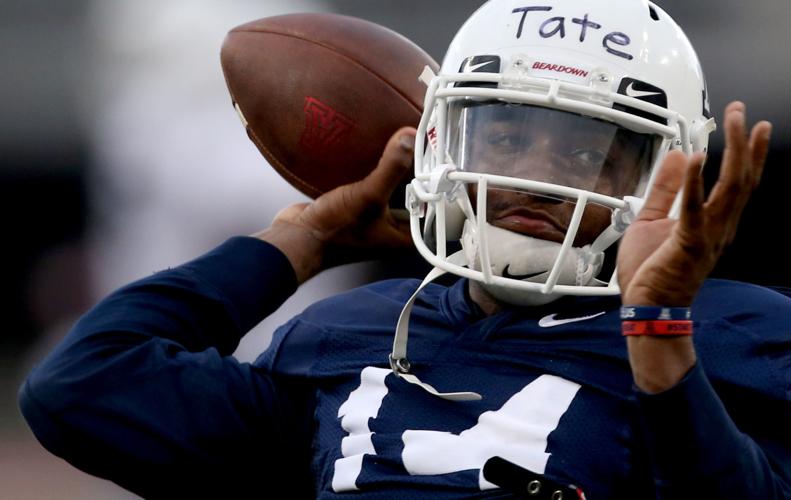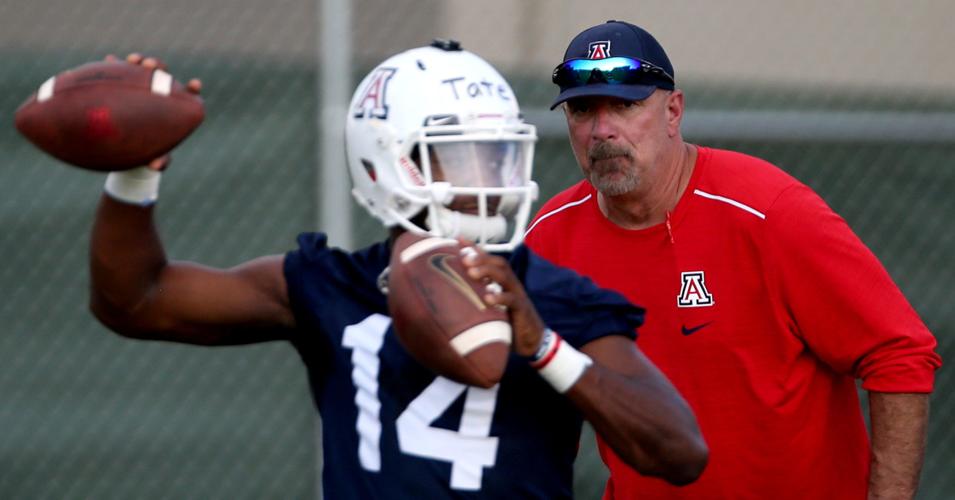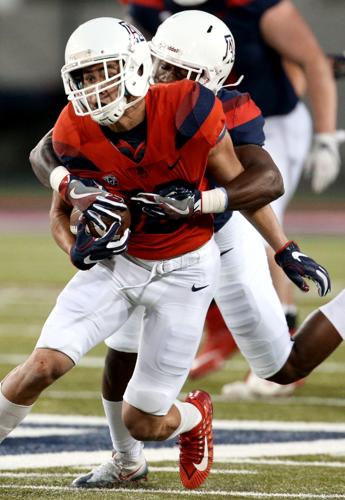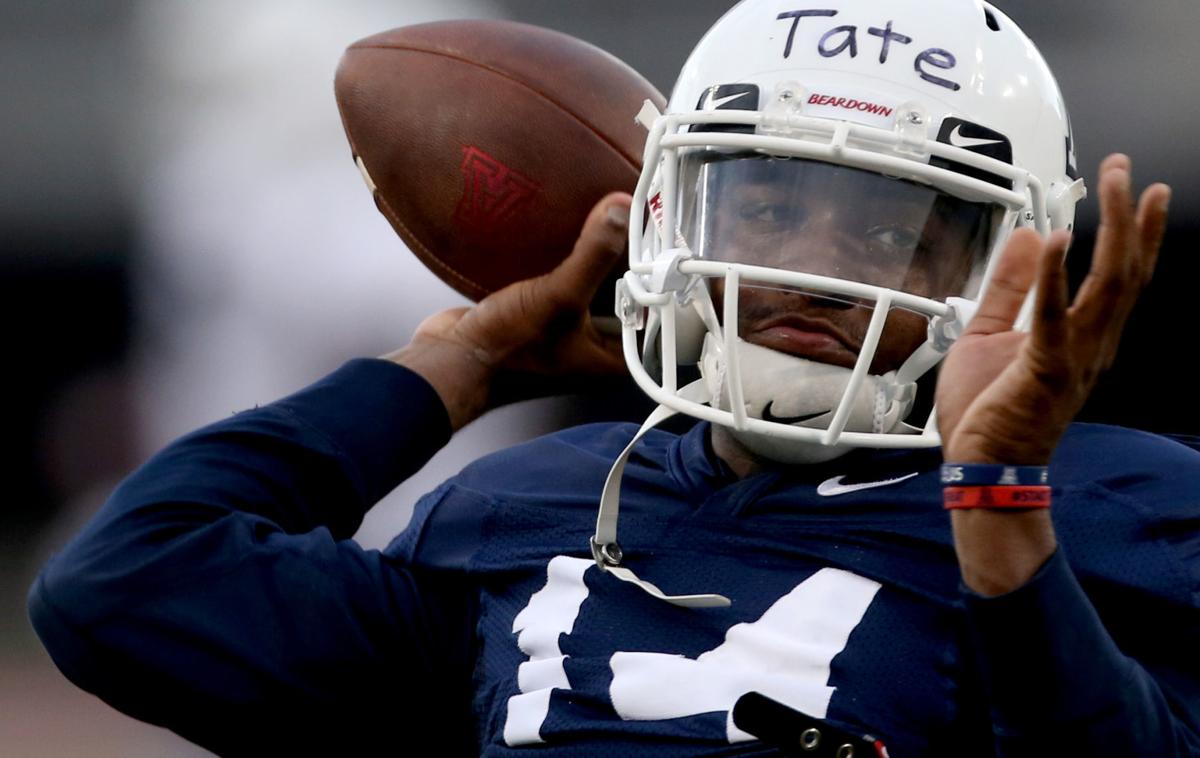Their collective mission, Kevin Sumlin has stated, is to transform Khalil Tate from an athlete who plays quarterback into a quarterback who happens to be athletic.
The latter, if it comes to fruition, would be Tate 2.0. That advanced version of the junior playmaker would cause many sleepless nights for opposing defensive coordinators.
We’ll get a glimpse of how far Tate has come under Sumlin and his staff when the Arizona Wildcats host BYU in the season opener Saturday night.
All the offseason reports from within the program have been positive, if not glowing. Tate has become more serious and well-rounded, teammates have said. He has become a respected leader, they have insisted.
To find out where Tate has grown the most — and where he still has room to improve — let’s examine his progress in two main areas: play on the field and leadership off it.

Offensive coordinator Noel Mazzone keeps a close eye on quarterback Khalil Tate in fall practice. Tate’s red-hot October last year put him on the national radar as a Heisman candidate in ’18.
On the field
It’s natural to assume Tate can do for Sumlin what Johnny Manziel did in 2012 and ’13. But Sumlin just won’t go there.
“It’s important to keep them in their own mold,” he said, referring to all the quarterbacks he has worked with as a coach. “But they’ve all been effective, and they’ve all won a lot of games. That’s what our goal is with Khalil.”
It’s also impossible to ignore that Manziel won the Heisman Trophy — as a redshirt freshman — in his first year under Sumlin at Texas A&M. Or that Case Keenum went from throwing 14 touchdown passes to 44 in his first year under Sumlin at Houston.
Tate threw 14 TD passes last season. It’s unrealistic to expect him to triple that total. But since they arrived in Tucson, Sumlin and QB coach Noel Mazzone have been working with Tate to improve his pocket-passing skills.
Mazzone had Tate and his fellow quarterbacks doing footwork drills on Day 1 of spring practice, and they haven’t stopped since. Tate also practices with a GoPro affixed to his helmet. That enables the coaches to determine whether his eyes are working in conjunction with his feet.
Tate is going to pass the ball more; he’s going to pass it more from the pocket; and he’s going to have to read the entire field at times.
“We’re asking him to do some things he maybe hadn’t had to do in the past,” Mazzone said. “There’s a learning curve for him. I think he’s really starting to embrace being a quarterback and not (just) a gamer. A quarterback works on his craft every day.”
Tate should have better timing with his receivers after throwing with them throughout the offseason. He didn’t get as many reps the previous summer, when he was competing with Brandon Dawkins for the starting job.
“I feel like the connection is a lot better than last year,” veteran receiver Cedric Peterson said. “You don’t want to go into summer going, ‘I don’t know which quarterback to work with.’ When you know the quarterback, it gives you more time in the offseason to watch film and build that chemistry.”
It’s not as if Tate was a subpar passer last year. He had a positive touchdown-to-interception ratio (14-9) and completed 62 percent of his throws.
Opponents did adjust to him after his red-hot October. His TD-INT ratio worsened, and his completion percentage and yardage per attempt fell.
However, Tate might have offered a sneak preview of version 2.0 in his final two games of 2017. In roughly six quarters of work against Arizona State and Purdue, Tate completed 71.8 percent of his passes for 434 yards. He threw for a career-high 302 yards and a school-record five touchdowns in the Foster Farms Bowl against the Boilermakers.
“Last year, kind of throwing him in, he relied a lot on his athleticism and playmaking ability,” tight end Bryce Wolma said. “I’ve seen him grow into a big-time quarterback mentally and physically. He’s making the right reads. He’s communicating out there.”

Receiver Cedric Peterson, Khalil Tate's roommate of two years, says the junior QB is ready to "take it to the next level."
As a leader
Peterson has been roommates with Tate for the past two years. He describes Tate as a “real cool dude” and “down-to-earth guy” but also as a prankster.
“He’s always clowning around,” Peterson said. “He always tries to mess with me, get me mad.”
How so exactly?
“Little things,” Peterson said. “Ask me a bunch of questions that he already knows the answer to. Just trying to get under your skin. He just thinks it’s real funny.”
Tate is the younger of two brothers, and that’s still part of his makeup. But several teammates have said he has changed this year. On the field, Tate is all business. As he put it, he’s “trying to make sure the team understands that I’m not playing any games.”
With more responsibility comes more professionalism. Although still only 19 years old, Tate has acted the part of a senior leader.
“You can just see that he wants to take it to the next level,” Peterson said. “All this publicity that’s coming in, everybody’s on him now … he has no other choice but to manage and lead the team.”
The nonchalant way in which Tate has handled his newfound fame has left Sumlin proud and pleased. He was especially appreciative of Tate keeping his Sports Illustrated cover shoot under wraps.
“The fact that he didn’t tell his parents about the SI photo shoot lets you know where his head is now,” Sumlin said. “He’s focused on getting better and winning games.”
How all of it manifests when it counts remains to be seen. Tate 2.0 might not be ready for full distribution until later in the season. But a prominent Sumlin protégé has a pretty good idea of what will transpire.
“They’re going to play to Khalil’s strengths and put him in a position to be successful,” said Texas Tech coach Kliff Kingsbury, who coached under Sumlin at Houston and Texas A&M. “When you’re that dynamic, they’re going to do everything they can to make sure he’s comfortable and playing at a super-high level.”







